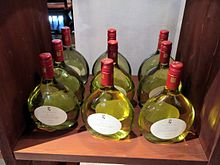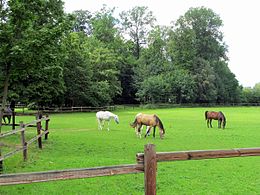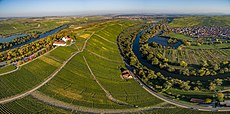 | ||
| Castell | ||
| federal state | Bavaria | |
|---|---|---|
| Residents | 819 (2019) | |
| height | 317 m | |
| no tourist info on Wikidata: | ||
| location | ||
| ||
The renowned wine village and princely seat Castell is located on a western foothill of the Steigerwald in Lower Franconia.
&groups=Maske,Track,Aktivitaet,Anderes,Anreise,Ausgehen,Aussicht,Besiedelt,Fehler,Gebiet,Kaufen,Kueche,Sehenswert,Unterkunft,aquamarinblau,cosmos,gold,hellgruen,orange,pflaumenblau,rot,silber,violett)
background
To Municipality of Castell Since the Bavarian regional reform in 1977, the two previously independent districts of Greuth and Wüstenfelden have also belonged. The municipality of Castell belongs to the administrative community Wiesentheid and to the district of Kitzingen.
little chronicle
On the ridge above Castell are extensive archaeological finds Castle and fortifications Already verifiable for the early and high Middle Ages. The place Castell (Latin for castle) was first mentioned in a document in 816 in a deed of foundation for the Megingaudeshausen monastery near Oberlaimbach (later relocated to Münsterschwarzach).
The Noble family first appeared in 1091: a noble Rupert calls himself “de Castello” for the first time in a Würzburg bishopric, and since 1202 the gentlemen of Castell have been holding the title of count.
Around 1266, the Grafschaft Castell was divided into a line from the upper castle on the Schlossberg, it remained with the Counts of Castell, and in a line from the lower castle on the Herrenberg, the castle from then on belonged to the burgraves of Nuremberg and the later Margraves of Brandenburg-Ansbach. In this certificate of division, the Schlossberg and Hohnart vineyards in Castell were named for the first time.
In the 14th century Castell was the capital of the county. In the Middle Ages, Castell was also a "wild bath" (spa and medicinal bath) popular with the aristocracy and the people because of the medicinal water that occurs in the area. It was first documented in 1399.


Both castles were destroyed in the Peasants' War in 1525, but only the upper castle on the Schlossberg was rebuilt: the castle of the margraves on the Herrenberg remained in ruins, the Brandenburg office of Castell was relocated to Kleinlangheim.
From 1600 to 1601 it was created New wild bath. However, as a result of the Thirty Years War, the number of bathers fell noticeably. The Wildbad was closed in 1680, after which the government officials of the Grafschaft Castell moved from the upper mountain castle into the buildings of the former Wildbad.
From 1607 to 1615 the new and extension of the castle was built on the Schlossberg above the town.
In 1680/84 Wolfgang Dietrich Graf zu Castell-Remlingen was able to buy back the former part of the Brandenburg village, he left his new one here Baroque castle erect.
In 1774 the Castell-Bank was founded as Gräflich Castell-Remlingen'sche Landes-Credit-Cassa, it was housed in today's Castell'schen Archive (building of the New Wildbad). Today the bank is Bavaria's oldest private bank.
As a result of secularization (1803), the rule of the Counts of Castell was dissolved in the Paris Treaties of July 12, 1806 (Rhine Federation Act), and the towns were added to Bavaria.
In 1898, Count Alexander zu Castell-Rüdenhausen and Ottilie von Faber, heiress of the pencil manufacturer Faber, married. The name Faber-Castell, known for pencils and writing implements, arose from this connection.
The community Casteller Ring was founded in 1950, the Protestant order has been on the nearby since 1957 Schwanberg.
getting there
| location | ||
| Distances (road km) | ||
| Kitzingen | 14 km | |
|---|---|---|
| Wurzburg | 38 km | |
| Schweinfurt | 41 km | |
| Bamberg | 70 km | |
| Nuremberg | 85 km | |
| Frankfurt am Main | 158 km | |
By plane
The nearest international airports are the Nuremberg Airport![]() (IATA: NUE), 79 km, approx. An hour's drive) and the airport Frankfurt
(IATA: NUE), 79 km, approx. An hour's drive) and the airport Frankfurt![]() (IATA: FRA) 157 km, approx. 1 ½ hours by car).
(IATA: FRA) 157 km, approx. 1 ½ hours by car).
By train
The Iphofen station is on the railway line Wurzburg - Nuremberg and is the stop for all regional trains on this connection. Another 11 kilometers by bus or taxi to Castell.
In the street
The easiest way to get to Castell supraregional is via the motorway ![]() , (Nuremberg - Wurzburg,
, (Nuremberg - Wurzburg, ![]() Wiesentheid), and further to reach a good 4 km via Rüdenhausen to Castell.
Wiesentheid), and further to reach a good 4 km via Rüdenhausen to Castell.
Via the expressway-like federal highway B286 with connection to the motorway ![]() (Main valley motorway, Bamberg - Schweinfurt,
(Main valley motorway, Bamberg - Schweinfurt, ![]() Schweinfurt Ost) and over Gerolzhofen and from Wiesentheid as before, Castell can also be reached from the north.
Schweinfurt Ost) and over Gerolzhofen and from Wiesentheid as before, Castell can also be reached from the north.
mobility
- Public transport: The bus routes in the region are managed by the Transport company association Mainfranken GmbH;
- Info: Timetables; Tel .: 01801 886 886; mailto: [email protected]; www.vvm-info.de;
Tourist Attractions


- Possibly church St. Johannis: built 1783-1792 by master builder Joseph Albert from Tyrol and at that time a replacement for the castle church. The pulpit altar made of Casteller alabaster is worth seeing inside.
- Castell Castle: the baroque palace was built between 1686 and 1691 as one of the first three-wing complexes in Franconia and based on the plans of the master builder Peter Sommer from Künzelsau. The castle building is inhabited and therefore not accessible to tourists inside.
- The formerly baroque Castle garden was converted into an English-style landscaped garden around 1820. Most of the garden is freely accessible and also serves as an area for various events.
- Upper mountain castle: The octagonal stair tower is still preserved.
activities
- Silvanerweg, Hiking trail on the Casteller Schlossberg with information boards about the castles and the vineyards on the Schlossberg and about the geology and climate in the region.
- Ball game path, Hiking trail through the vineyards at the ball game.
Regular events
- Casteller wine festival, on the 3rd and 4th weekend in July in the palace garden.
- Wine hiking day, every year on the 1st or 2nd Sunday in September.
- Citizens' parade to the parish fair, the last weekend in October.
shop
Except for wine and accessories, there are no special shopping opportunities in Castell.
kitchen
- 1 Gasthaus zum Schwan, Birklinger Strasse 2, 97355 Castell. Tel.: 49 9325 90133, Fax: 49 9325 90134, Email: [email protected]. Kitchen with mainly regional dishes.Open: Opening times: Sun from 11 a.m., Mon, Thu - Sat 11 a.m. - 2 p.m. from 5 p.m., Tues-Wed are closed.Price: Overnight stays are possible: single rooms from € 55, double rooms from € 75.
- 2 Castell wine barn, Schlossplatz 3, 97335 Castell (directly connected to the castle, as well as the Fürstlich Castell'sche domain office). Tel.: 49 9325 9809949, Email: [email protected].Wine restaurant, vine arbor with summer terrace in the former horse stable of Castle Castell.Open: Mon Tue are closed, Wed - Fri 12.00 p.m. - 2.30 p.m. & 6.00 p.m. - 9.00 p.m., Sat - Sun 12.00 p.m. - 9.00 p.m.Accepted payment methods: Maestro, Mastercard, Visa.facebook url used
Wine


In the turmoil of the Thirty Years' War, around 75% of the Franconian wine-growing areas were lost, and there was also a deterioration in the climate in the form of a "little ice age".
Reitsteig is the name of the 16 hectare vineyard in which a total of "25 Austrian Fechser" were planted on April 10, 1659, this date stands for the first Silvaner planting in Germany, the name of the vine in use today is based on the presumed origin of wild vines in the Danube valley derived. The particularly hardy Silvaner is also known as Sylvaner or Frankenriesling, Johannisberger, Arvine Grande, Gros-Rhin, Gamay Blanc, Zeleny and Silvania and was the most cultivated grape variety in Germany with more than 30% of the area until the 1970s the share something.
In the interplay of soil and climate, the Silvaner produces particularly authentic and recognizable wines for the entire Franconian wine-growing region.
- Princely Castell's domain office, Schlossplatz 5, 97355 Castell. Tel.: 49 9325 601 60, Fax: 49 9325 601 88.
- The Fürstlich Castell’sche Domainamt operates organic viticulture on 70 hectares and is the oldest winery in Franconia and the largest private winery in Bavaria. The wines of the Fürstlich Castell’sche Domainamt are also available at the list price outside of business hours (Sundays) in Castell wine barn.
- Brügel winery, Hauptstrasse 49, 97355 Castell-Greuth. Tel.: 49 9383 7619, Fax: 49 9383 6733, Email: [email protected]. Vineyard with 7.60 hectares of cultivation area.Open: Monday to Friday from 9 a.m. to 12 p.m. and 1 p.m. to 6 p.m., Saturday from 9 a.m. to 12 p.m. and 1 p.m. to 5 p.m. and by appointment.
nightlife
accommodation
There is a guest house and several providers of holiday apartments in the village.
health
The nearest pharmacy is in Wiesentheid
| Brief information | |
| Phone code | 09325 |
|---|---|
| Post Code | 97355 |
| Mark | KT |
| Time zone | UTC 1 |
| Emergency call | 112 / 110 |
Practical advice
- Deutsche Post branch, Im Oberdorf 3, 97355 Castell.
trips

- The Schwanberg, popular excursion destination with a view, castle, castle park and cafe can be reached on the driving route (approx. 7 km) or as a hike in approx. two hours on foot.
- Further Wine places in the immediate vicinity are for example Abtswind (approx. four kilometers), Rödelsee (approx. 9 km), Iphofen (approx. 12 km) or Volkach on the Main (approx. 25 km);
- The Steigerwald is on the doorstep;
literature
Web links
- http://www.castell-gemeinde.de/ - Official website of Castell
- Extensive Information on the history of Castell see also: www.kulturpfad-grafen-castell (District Office Kitzingen);
- Weinbauring Franken e.V.: www.weinbauring.de;
- Area wine advertising Frankenwein-Frankenland GmbH: www.frankenwein-aktuell.de;




